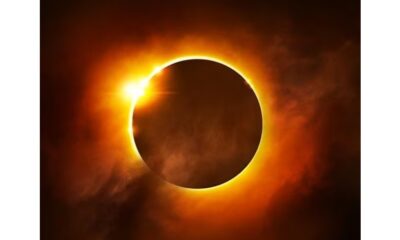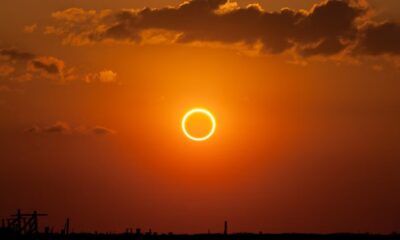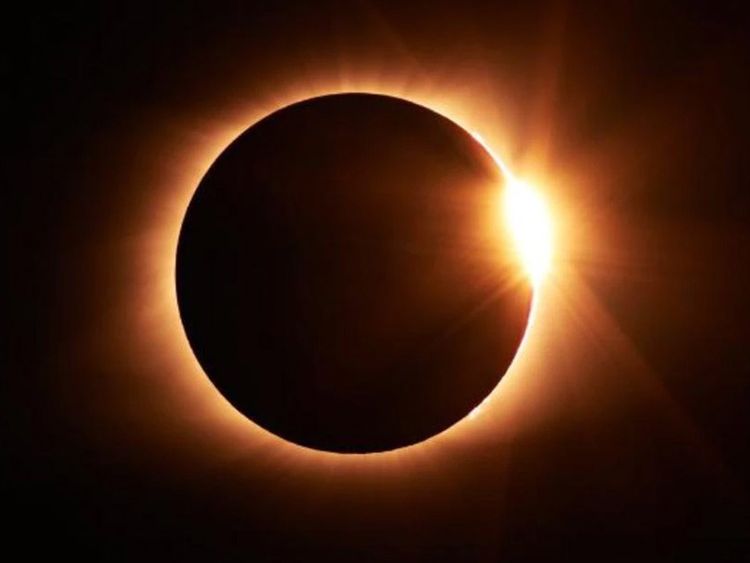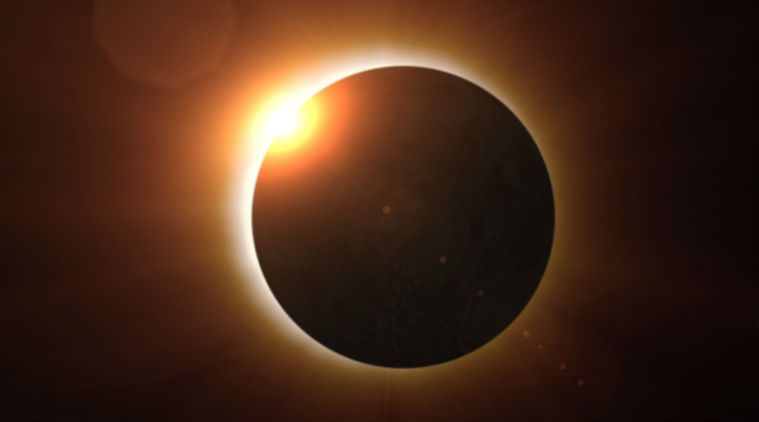Science
Solar Eclipse with the “Ring of Fire.” Coming Soon, In Which Countries it Will be Visible
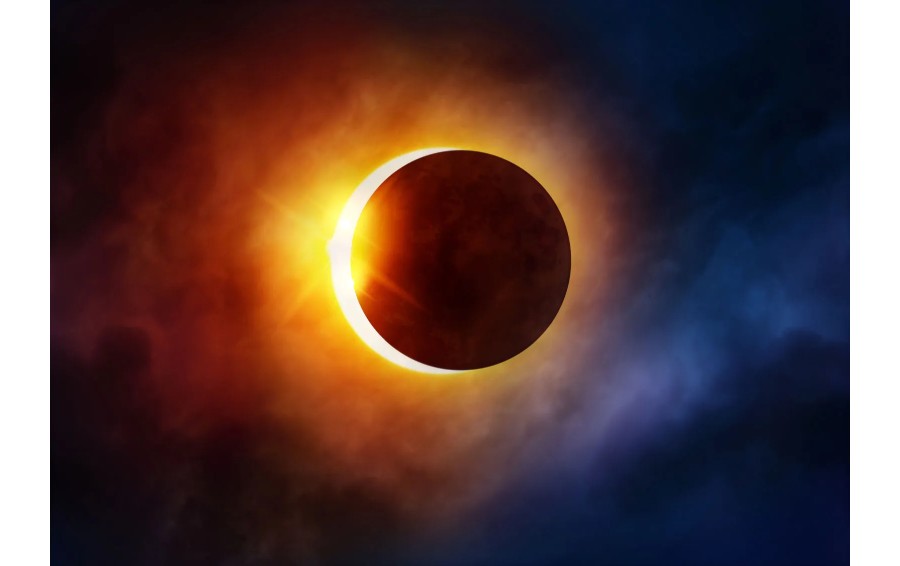
On October 14, an annular solar eclipse will be visible in the skies over North, Central, and South America, providing a unique spectacle for those in its path and a once-in-a-lifetime chance for scientists.
According to Peg Luce, acting director of the Heliophysics Division at NASA headquarters, the spectacular celestial event will let millions of people to experience “the awe and wonder of seeing a beautiful ring of fire eclipse.”
The term “ring of fire” refers to the appearance of annular solar eclipses, which are total solar eclipses but can’t completely cover the sun because they occur when the moon is at its furthest point from Earth in its orbit.
Instead, the so-called ring of fire is actually the sun’s flaming light around the moon’s shadow.
From the Oregon coast to Texas’ Gulf Coast, the annular solar eclipse will be visible in Oregon, Nevada, Utah, New Mexico, and Texas. It will start in the United States at 9:13 a.m. PT (12:13 p.m. ET). Additionally, regions of California, Idaho, Colorado, and Arizona will be able to see the lunar shadow. In the US, the eclipse will end around 1:13 p.m. ET (12:03 CT).
The eclipse will begin in the United States and go through Mexico, Belize, Honduras, Panama, and Colombia before coming to a finish at Natal, Brazil, off the Atlantic coast of South America.
According to NASA, a partial solar eclipse in the shape of a crescent will be seen on October 14 in all 49 of the continental US states, including Alaska, weather permitting. To find out when the eclipse will pass over your region, use the agency’s interactive eclipse map.
Having trouble seeing the eclipse? According to Kelly Korreck, the eclipse program manager at NASA, a live feed will be available starting at 11:30 a.m. ET on the day of the eclipse, featuring views from Kirbyville, Texas, White Sands, New Mexico, and Albuquerque, New Mexico.
“The next annular eclipse seen in this part of the country is actually going to be in 2046,” Korreck said. “It’s going to be a long stretch before we will see this phenomenon again, so we’re really encouraging folks to go out there and observe safely.”
What to see
There will be multiple stages to the annular eclipse, which will be visible to those in its path. First, a partial eclipse in the shape of a crescent will be produced as the moon starts to move in front of the sun.
The moon will pass in front of the sun directly an hour and 20 minutes after the partial eclipse starts, causing the ring of fire (also known as annularity). This stage will last one to five minutes, depending on where you are in the path.
The sky will become darker during annularity, but not completely as during a total solar eclipse, when all of the sun’s light is blocked. According to NASA, animals may act as they do at sunset and the air may feel cooler.
Before disappearing from view, the moon will continue to travel across the sun for another hour and 20 minutes, producing another partial eclipse.
Safe viewing
There is never a period of an annular eclipse that is safe to see with the naked eye because the sun’s light is never entirely blocked, and it is never safe to stare directly at the sun without employing specialized protection.
Wear certified eclipse glasses or a portable solar viewer to see the annular eclipse. Separately, you can view the sun with a telescope, pair of binoculars, or camera that contains a front-facing solar filter that functions similarly to eclipse-viewing glasses.
“You need certified ISO 12312-2 compliant solar eclipse glasses. There are plenty of safe sellers online,” said Alex Lockwood, strategic content and integration lead for the Science Mission Directorate at NASA headquarters. “We cannot stress enough how important it is to obtain a pair of safe certified solar eclipse glasses in order to witness this annular event.”
Instead of eclipse glasses or solar viewers, which are thousands of times darker and subject to an international standard, you should use sunglasses. Use only intact eclipse glasses or solar viewers. Do not use broken or torn items.
While wearing eclipse glasses or utilizing a handheld solar viewer, avoid looking at the sun via any optical device, including binoculars, a telescope, or a camera lens. This advice comes from NASA. Given how concentrated solar rays may be through an optical equipment, they can still burn through the filter on the glasses or viewer and inflict serious eye injury.
Indirect viewing of eclipses is also possible via a pinhole projector, such as a hole punched in an index card. These work by holding up the card while standing with your back to the sun. On the earth or other surfaces, the pinhole projected an image of the sun. But never stare through the pinhole with your back to the sun.
Apply sunscreen and wear a hat to protect your skin if you want to spend some time outside while watching the eclipse.
The next eclipse
On April 8, 2024, a total solar eclipse will be visible in parts of Mexico, Canada, and more than 10 US states.
The eclipse will begin its path over North America over the South Pacific Ocean. The first point of totality on the course will occur over Mexico’s Pacific coast at 11:07 a.m. Pacific Time.
Texas, Oklahoma, Arkansas, Missouri, Illinois, Kentucky, Indiana, Ohio, Pennsylvania, New York, Vermont, New Hampshire, and Maine will all be included on the route. It will then cover southern Ontario, Quebec, New Brunswick, Prince Edward Island, and Nova Scotia before coming to a conclusion at 5:16 p.m. (3:46 p.m. ET) on Newfoundland’s Atlantic coast.
What we can learn from eclipses
Eclipses give researchers the chance to learn more about the sun and its unusual interactions with Earth. During the annular eclipse, NASA will launch three sounding rockets to track how the reduction in sunlight affects the ionosphere, the planet’s upper atmosphere.
In the ionosphere, which is located about 50 miles (80.5 kilometers) above Earth’s surface, air turns electric. The atmospheric layer that results from the separation of electrons from atoms by the sun’s UV rays is dense with charged particles. However, the atoms unite again at night to become neutral.
The ionosphere’s temperature and density decrease and then increase over a shorter period of time during the eclipse, which results in a more dramatic change.
“If you think of the ionosphere as a pond with some gentle ripples on it, the eclipse is like a motorboat that suddenly rips through the water,” said Aroh Barjatya, designer of the sounding rocket mission and a professor of engineering physics at Embry-Riddle Aeronautical University in Florida, in a statement. “It creates a wake immediately underneath and behind it, and then the water level momentarily goes up as it rushes back in.”
During the 2017 US total solar eclipse, atmospheric changes were noted.
“All satellite communications go through the ionosphere before they reach Earth,” Barjatya said. “As we become more dependent on space-based assets, we need to understand and model all perturbations in the ionosphere.”
Before, during, and after the eclipse’s peak, rockets will be fired, flying just outside the annularity’s path, to collect data on the ionosphere’s alterations between 45 and 200 miles (72 and 322 kilometers) above the planet.
Both the annular and total solar eclipses will be used for an experiment by amateur radio operators to determine how these natural occurrences alter radio wave propagation. The signal’s power and its path will be tracked by operators in various locations. Because the sun directly affects the ionosphere, which increases radio communication range, scientists are interested in measuring this distance. However, this may alter if the moon obscures the sun.
Scientists are keen to document the sun’s pinnacle of activity as it approaches solar maximum in the middle to late 2024 through a range of measurements, such as monitoring the sun’s corona, or heated outer atmosphere, which can only be observed during eclipses.
-

 Sports4 weeks ago
Sports4 weeks agoAl Ahly vs Inter Miami, 2025 FIFA Club World Cup – Preview, Prediction, Predicted Lineups and How to Watch
-
Health3 weeks ago
Back to Roots: Ayurveda Offers Natural Cure for Common Hair Woes
-

 Tech3 weeks ago
Tech3 weeks agoFrom Soil to Silicon: The Rise of Agriculture AI and Drone Innovations in 2025
-

 Startup4 weeks ago
Startup4 weeks agoHow Instagram Is Driving Global Social Media Marketing Trends
-

 Science5 days ago
Science5 days agoJuly Full Moon 2025: Everything You Should Need to Know, When and Where to See Buck Moon
-

 Sports3 weeks ago
Sports3 weeks agoFIBA 3×3 World Cup 2025: Full Schedule, Preview, and How to Watch
-

 Gadget3 weeks ago
Gadget3 weeks agoThings to Know about Samsung Galaxy S26: What’s New and What’s Next
-

 Sports4 weeks ago
Sports4 weeks agoWorld Judo Championships 2025: Full Schedule, Date, Time, Key Athletes and How to Watch

